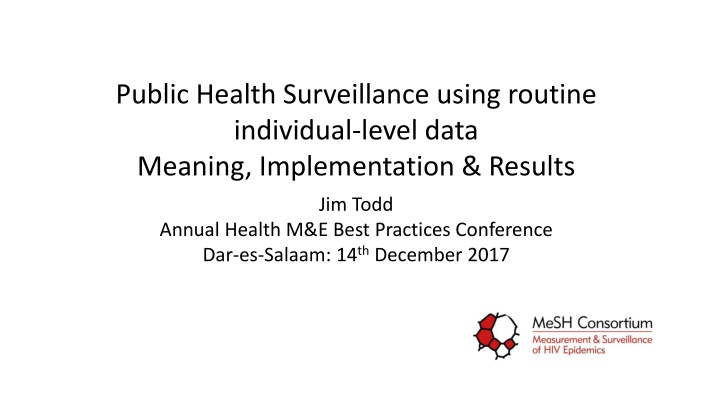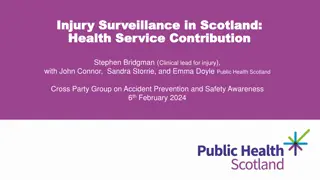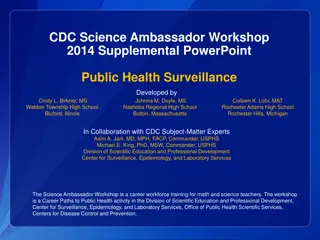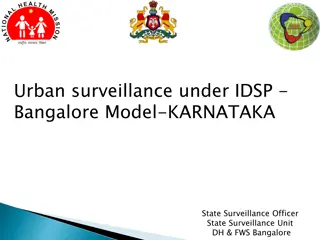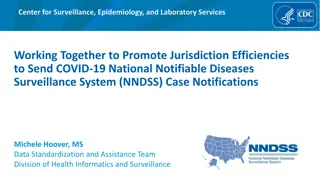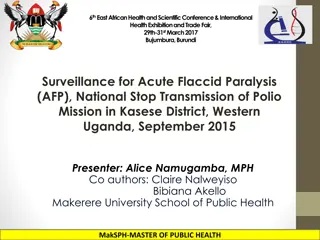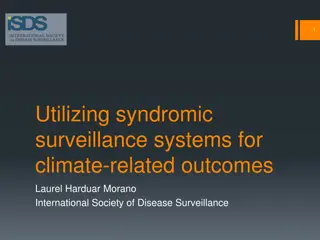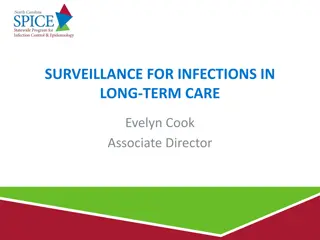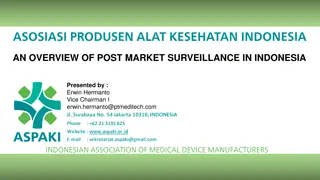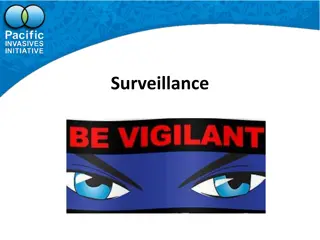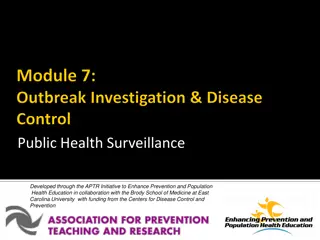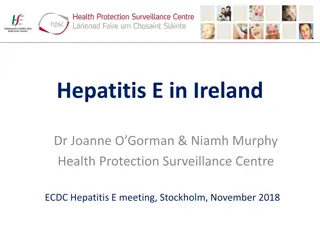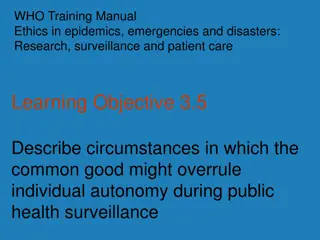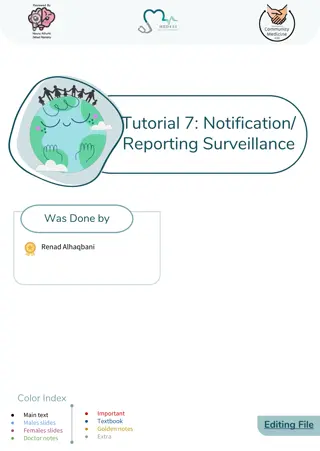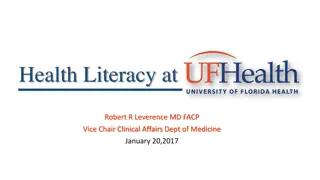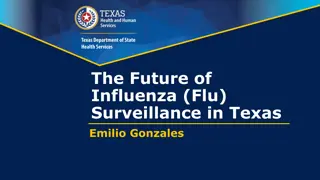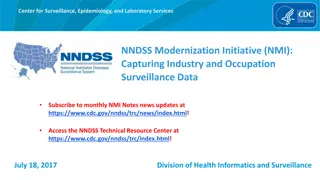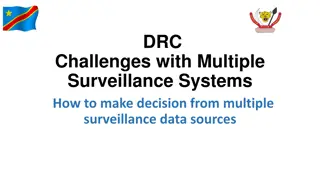Public Health Surveillance Using Routine Data: Implementation & Results
This presentation discusses the utilization of routine individual-level data for public health surveillance, including its meaning, implementation, and results. It explores the objectives, benefits, and limitations of using routine data in monitoring public health, with a focus on key features, areas of application, and potential challenges. The talk also touches upon the importance of conducting SWOT analyses and provides an example project pilot for Health Testing Services and Clinical Treatment Center linkage.
Download Presentation

Please find below an Image/Link to download the presentation.
The content on the website is provided AS IS for your information and personal use only. It may not be sold, licensed, or shared on other websites without obtaining consent from the author.If you encounter any issues during the download, it is possible that the publisher has removed the file from their server.
You are allowed to download the files provided on this website for personal or commercial use, subject to the condition that they are used lawfully. All files are the property of their respective owners.
The content on the website is provided AS IS for your information and personal use only. It may not be sold, licensed, or shared on other websites without obtaining consent from the author.
E N D
Presentation Transcript
Public Health Surveillance using routine individual-level data Meaning, Implementation & Results Jim Todd Annual Health M&E Best Practices Conference Dar-es-Salaam: 14th December 2017
Objectives Public Health Surveillance Review Routine data What can it tell us? WHO and national priorities What is new? Conducting a SWOT Why is it important? Example project pilot of HTS-CTC linkage Benefits and limitations of using routine data in Public Health Surveillance Way forward.
Public Health Surveillance WHO definition: The continuous, systematic collection, analysis and interpretation of health-related data needed for the planning, implementation, and evaluation of public health practice. The ongoing systematic collection, analysis, and interpretation of outcome-specific data for use in planning, implementing, and evaluating public health practice
Key features of surveillance data Ongoing collection of data Practicality Uniformity Rapidity Usefulness Timely information for action
Areas where surveillance is used Vital data - Demographic surveillance of births and deaths (DSS) Disease monitoring and screening for disease - underlying prevalence (or incidence) of disease (DHS) Monitoring risk behaviours (identifying those at risk). Drug sensitivity to inform changes in drugs Early notification of outbreaks of infectious diseases for Public health action (outbreak investigation) Program evaluation (eg. vaccination)
Questions: Questions: - Can we use data collected at routine health care settings? - What are the advantages & disadvantages? - This is used in many developed countries So why not here?
Routinely collected data Data collected for routine purposes, such as patient management. PMR used for clinical management of health conditions Routine monthly & quarterly aggregate reports Medical and educational programme reporting (tests, questions, etc) Limitations (biases due to selection or recording of data): Completeness, missing data present a bias. Accuracy, we have no control over the collection Coverage, not all cases included Comparability, different clinics have different protocols Difficulty identifying outcomes experienced by individuals
Person centred guidelines First priority is to provide a service to an individual Focus on needs Assist in achieving interests, goals, and dreams Employs person first language, and activities Recognise functional strengths and limitations Second priority to use the data for the system Programme implementation Surveillance of known risks, weaknesses, and difficulties Action to resolve identified problems
WHO guidelines for HIV surveillance Aggregate data inadequate to address patient care and treatment Focus on the patient, and their needs A cascade of linked services for care Reporting on access to each level Concentrate on each case and what they need. First priority to provide the services Second priority case based surveillance, by recording key events in clinical care.
Case-based surveillance overview Individual-level notification of diseases of public health importance to ministries of health for disease prevention, response, and control HIV/AIDS case surveillance routine in high income countries Provides longitudinal, un-duplicated data of persons diagnosed with HIV Accurate count along cascade beginning with diagnosis and ending with death or viral suppression 10
National guidelines for health information systems (HIS) New draft guidelines in 2017, building on HSSP III Produce overarching policy guidelines on HIS Strengthen disease and demographic surveillance Improve routine health management information Reduce burden on health care workers Enhance communication to policy makers, and feedback to service providers Rationalise, harmonise and coordinate information systems, so they serve the clinical care, and improve decision making.
Questions: How do we start to implement patient centred surveillance? What is needed for case-based surveillance of HIV? Can Tanzania make the change from the current aggregate data reporting?
Identifying the reporting system: Strengths, weaknesses, opportunities & threats Importance of finding out what is happening BEFORE changing the system Example SWOT for case-based surveillance. Conducted in Tanzania September 2015
Strengths, weaknesses, opportunities & threats (SWOT) Objectives: Determine resources, services, data, & systems for changing to Case-Based Surveillance (CBS) Gauge feasibility of implementation of CBS using routine data from HIV testing, ART initiation, Viral load suppression, and deaths in HIV cases Identify the demands of data collection and data management on HR Methods: Standardised protocol, review of documents, SOP, tool for data collection, visit to health facilities
Tanzania CBS SWOT Strengths Strong foundation for CBS - data are collected and entered into individual patient records and MoH registers Existing procedure for reporting aggregate data up from clinics to sub-national and national level Understanding of unique identifiers is present throughout M&E system SWOT team at laboratory in a health centre
Tanzania CBS SWOT - Weaknesses Over reliance on paper-based registers and aggregate reporting Inadequate patient unique identifiers (duplicates / poor linkage from HCT to care) Data quality needs to be addressed (little data use at local / sub- national level) SWOT team with Regional Officers in Mwanza
Tanzania CBS SWOT - Opportunities Interest among stakeholders and basic systems in place to build a strong CBS system Defining a unique identifier which would link HIV services, and would facilitate de-duplication CBS would necessitate better data quality systems / staff training Interview with key personnel
Tanzania CBS SWOT - Threats Resource and staff limitations Unacceptability (to facilities) of patient level data flowing to national level threat to patient confidentiality Data quality needs to be high and this may impose constraints on the delivery of CBS Approach and entrance to health facility
SWOT conclusions Develop policies to support CBS Systems are in place, specific resources need strengthening Integrate and link the different data sources (HTS, CTC, laboratory) Develop both infrastructure and data skills in HW and IT personnel DQA and data cleaning procedures be improved Require unique identifiers for clinics and patients Master Facility List in 2016 Master Patient List being developed
Implementing new systems An example Linkage of HTS with CTC data Example from pilot in Magu, Mwanza
Background Tanzania SWOT for HIV case based surveillance Identified the linkage between HTS and CTC as a weakness Need for unique identifiers for HIV notification of new HIV positives Feasibility of collecting names and confidential information at HTC Ministry of Health (MoHCDGEC) new HIS guidelines (Oct 2017) Stress integration of data systems within health facilities Reduce burden on health care providers Integration of HTS and CTC is a priority in NACP Pilot study of new CTC database, integrates HTS services into the data Uses fingerprints to track individuals within the system Not yet approved for trial
Background in Mwanza Within Magu HDSS (by TAZAMA, NIMR Mwanza) Since 2008, used an expanded referral form for HTS to CTC In Kisesa HC clinics (VCT, ANC and PITC) & community sero-survey Community sero-survey (2015/16) Minimum 43% of new HIV diagnosis report to Kisesa CTC within 6 months HIV patients may report to other CTC Distance between testing site and CTC is an issue for patients Real time record linkage between HTS and HDSS population Facility HTS higher linkage to care than community HTS (HR=5.57, 95%CI 3.7-8.3) Median time to CTC =1 day in Facility HTS; =49 days from community HTS
Objectives To establish a surveillance process for linkage of newly diagnosed HIV cases to the care and treatment clinics (CTC) Sustainable, low cost surveillance for use in districts, or nationally To develop and pilot the surveillance using routinely collected data Assess duplication, and the proportion who repeat HIV positive tests Assess factors associated with successful linkage to care Qualitative study to determine patient expectations and reasons for linkage, and non linkage to care Estimate the second 90 in the 90:90:90 indicators
Methods (pilot implementation) Time period of 12 months (1st Jan 2017 to 31st Dec 2017) Capture HIV positive diagnoses in 16 clinics in Western Magu district Use modified referral form from HIV testing services (HTS) for referral to CTC Capture all new attendance at CTC in the same 16 clinics Collect the referral forms from CTC, or capture the same data from the patients on enrolment in CTC Field worker to collect data from all clinics monthly Additional data from the previous 6 months (2016) HTS register, and from CTC database Qualitative interviews Patients enrolled in CTC and not enrolled (all adults) Health care workers referring patients
Area: Western part of Magu district, Mwanza, Tanzania Study health facilities: 3 health centres, 13 dispensaries - 14 government, 2 private - 2 in fishing villages, 7 roadside communities, 7 rural settlements Clinics in the health facilities: - 16 VCT clinics (all HF) - 16 ANC clinics (all HF) - 13 PMTCT clinics - 9 with full CTC clinic Kisesa H.C. Magu District Hosp
Two part referral form LHS collected from HTS Data from current registers Residence & phone # RHS kept by patient Brought to CTC If referral form not brought Similar form for CTC Majority of data already collected at CTC enrolment Contains much more data than MoH referral form
Results (Jan-Oct 2017) HTS (16 clinics) 1117 Seen in CTC (13 clinics) 821 (73%) Total Sex: Female 656 (59%) 488 (57%) Clinic type: VCT 320 (29%) 239 (21%) 526 (47%) 257 (31%) 172 (21%) 368 (45%) ANC PITC Residence: Catchment area (9 wards) Outside district 927 (83%) 99 (8.8%) 690 (74%) 56 (56%) Repeat testing HIV positive 165 (15%) 23 (2%) in 2017 108 (76%) 21 (91%) All provided a residence and person who lived in the same house 520 (47%) provided a telephone number
Factors associated with attendance at CTC Timing: 655 (80%) on the same day, 135 (16%) within week Age: lowest in those aged 25-34 years Pregnancy: 85% of pregnant women linked to care Compared to 72% of men and 72% non-pregnant women Type of facility: 80% in health centres, 80% in smaller facilities with CTC, 91% in pregnant women attending facilities with PMTCT only 24% in facilities with no CTC or PMTCT, 25% in non-pregnant women attending facilities with PMTCT only, 27% in men attending facilities with PMTCT only Further work on ART initiation & retention
Qualitative findings: Health facility factors Services: people would like to go to health facilities, where they find services Distance and cost: Minimum or zero cost preferred Trust in providers: there at X health facility, they care [for] clients Delays: here at Y, there is poor service, you come at 7AM, you find no health provider Identification: [if] there is a new/another procedure, I find it difficult HCW: Referral forms useful and easy to use.
Qualitative findings: Health journeys personal factors Ignorance: I didn t have any Idea; my wife was pregnant, when we came for test Misconceptions: I had a normal fever I just know this is Malaria Denial: the second test result, I will see the kind of result I do not feel like have something, or rather suffers from diseases Realisation: this will be your lifetime problem Social stigma: is my great concern, at the open space, where I can go and take the drugs Coping: I came to realize that they are both using the drugs with his first wife Acceptance: I am not alone I am not the first
Discussion Referral form important clinically, and useful for surveillance. Virtually all clients used it when enrolling in CTC HCW found it convenient, useful, quick, and easy to use Feasible, affordable, and easy to use for CBS surveillance For 2ndof the 90 s: Estimate 73% of HIV positive linked to care. >80% if CTC is in same facility as HTS (most enrol on the same day) Access factors: Convenience of services, trust in the service providers, and the quality of the service Need to implement at district level. Build in local analysis of the data by district staff
Conclusions to pilot HTS-CTC linkage project Referral forms provide a low-cost, sustainable way to link HTS clients to enrolment in care. Useful for improved clinical outcomes & for surveillance Can be done by existing facility staff Patients willing to provide extra information needed for surveillance Devolvement of CTC to every health facility in Tanzania would improve linkage, and help achieve the WHO 90:90:90 target. Implementation needs to be integrating into district services Local surveillance of HIV testing services and linkage to care De-duplication of repeat testers
Benefits and Limitations Clinical care is the prime importance of health care systems Surveillance using routinely collected data supports better clinical care: Concentrates on key clinical outcomes Improves data quality, through use and analysis Builds skills among health workers and IT professionals Integrated with reality on the ground (practical & sustainable) Requires investment in infrastructure and personnel
Next steps Identify the key events to monitor for HIV surveillance HTS, CTC enrolment, ART initiation, VL suppression, retention Develop innovative ways to collect these data from clinical services Integrate the data systems across services Pilot and test ways to improve integration Develop de-duplication application for CBS of HIV Analyse and use the existing data Provide results for policy and implementers Feedback to local health care workers Develop local capacity for management and analysis
Acknowledgements NACP, MoHCDGEC, implementors HIV services in Tanzania Donors, funders and partners to HIV programmes Districts, Health Facility staff, and those delivering HIV care & treatment Researchers in NIMR, TAZAMA project, and others involved with surveillance using routinely collected data LSHTM, MeSH & funding from B&MGF for this research
